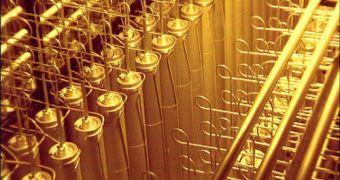Uranium enrichment basically refers to the separation process between the uranium-238 and the uranium-235 isotopes. Because only uranium-235 can be used for fission reactions - such as those experienced in nuclear weapons and nuclear powered reactors - and uranium-235 makes up for less than 1 percent of the whole uranium reserve on Earth, engineers must use an enrichment process to extract the fissionable material.
How it works
Uranium cannot exist freely on Earth because it is highly reactive to a variety of chemical elements. Therefore it can only be found in compounds, such as uranium oxides. In order to extract a concentrated mass of uranium-235, the uranium ore is first reacted with a powerful acid, usually hydrofluoric acid, to turn it into uranium hexafluoride, which, by the way, is a gas.
The whole mass of gas is then inserted into a centrifuge that separates the two isotopes by subjecting them to centrifugal forces equivalent to about 1,000 G as it spins. Uranium-238 is slightly heavier than the uranium-235 isotope, thus it is more easily pushed towards the outer regions of the centrifuge, leaving behind a concentrated mass of uranium-235 in the central region of the centrifuge.
The uranium hexafluoride gas containing the U-235 isotope, can then be drawn out and again passed through a centrifugal stage. Usually, a uranium enrichment plant can contain up to several thousand centrifuges, in order to obtain a high concentration of uranium-235. Once the process is complete, uranium can again be turned into a metal form by having the uranium hexafluoride gas react with calcium, leaving behind pure uranium and a calcium fluoride salt. It can be then directly used as fuel for nuclear power plants or to create nuclear weapons.
The centrifuges themselves must rotate at speeds up to 100,000 rotations per minute, thus requiring light, strong, balanced rotors and high speed bearings, usually magnetic. The combination of technological requirements impedes most countries from making use of such facilities, but with the help of computer-controlled machines the process can be easily simplified.

 14 DAY TRIAL //
14 DAY TRIAL //